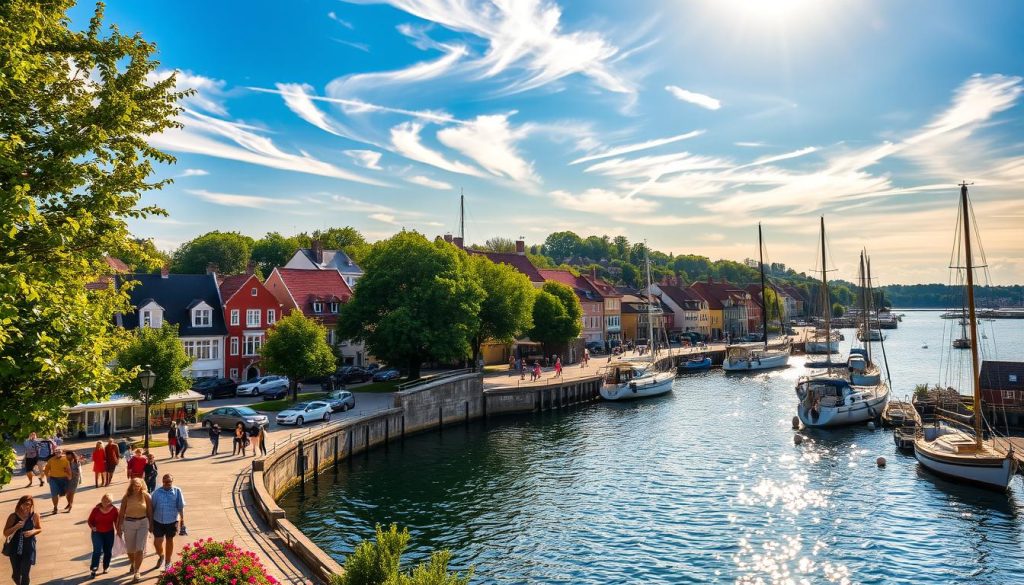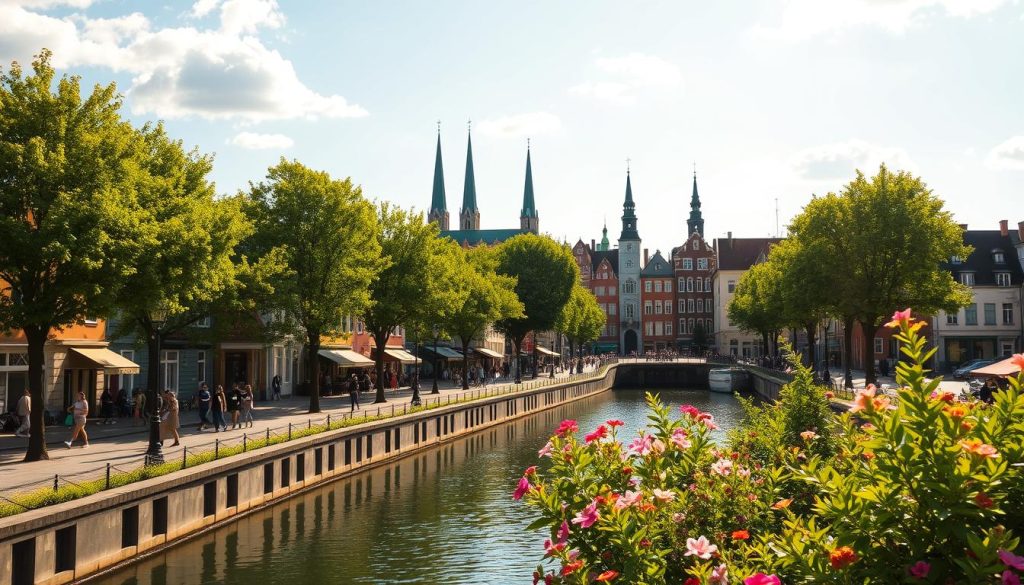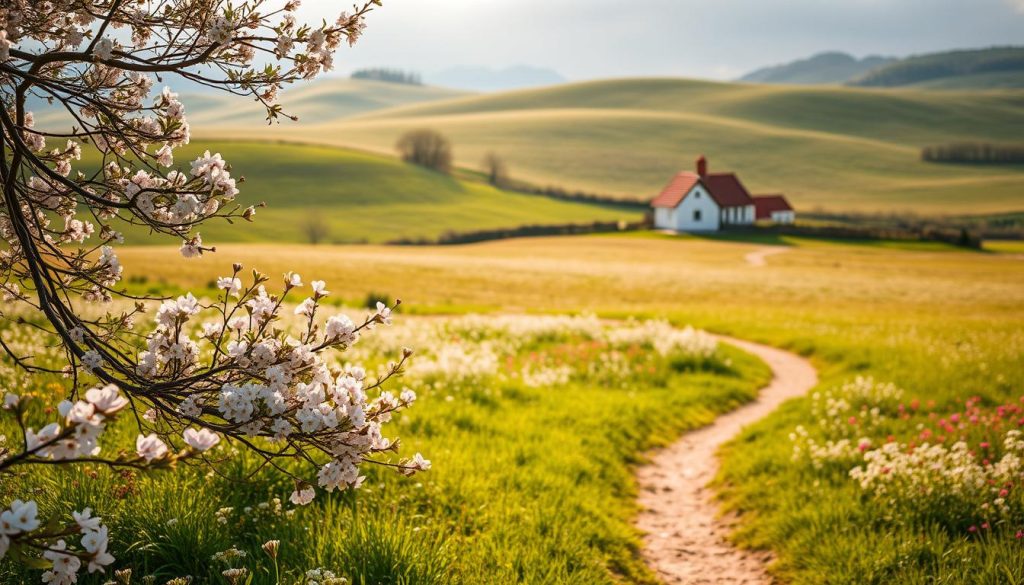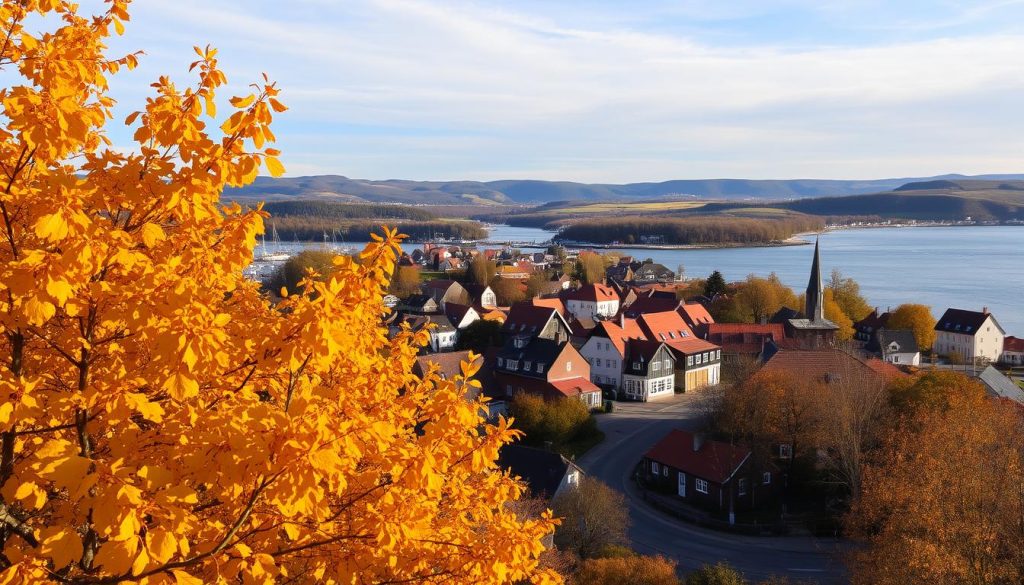Ever wondered why timing is everything when planning a trip to a country known for its picturesque landscapes and mild climate? Denmark, with its unique blend of historical charm and temperate weather, offers an unforgettable travel experience. But to truly make the most of your visit, you need to know when to go.
This country is a traveler’s dream, especially during the summer months. Longer days and pleasant weather make it ideal for exploring its vibrant cities and serene countryside. Whether you’re into cultural festivals, outdoor adventures, or simply soaking in the local vibe, timing your trip right can make all the difference.
In this guide, you’ll discover the best times to visit, seasonal variations, and local events that can elevate your journey. Ready to plan a trip that fits your schedule and desired weather experience? Let’s dive in!
Key Takeaways
- Denmark’s mild oceanic climate makes it a year-round destination.
- Summer offers long days and perfect weather for outdoor activities.
- Timing your visit can enhance cultural and festival experiences.
- Seasonal variations provide unique opportunities for exploration.
- Planning ahead ensures a seamless and enjoyable travel experience.
Overview of Denmark’s Climate and Seasonal Variations
Understanding the climate of a destination can transform your travel experience. Denmark’s weather is shaped by its unique position between the Atlantic Ocean and continental Europe. This creates a temperate maritime climate with mild winters and cool summers.
The oceanic influence ensures that extreme temperatures are rare. Winters are relatively mild, while summers stay comfortably warm. This balance makes it a year-round destination for travelers.
Understanding Denmark’s Unique Oceanic Influence
Denmark’s climate is heavily influenced by the surrounding seas. The Gulf Stream brings warm waters, moderating temperatures throughout the year. This results in fewer temperature extremes compared to other northern regions.
Even in winter, temperatures rarely drop below freezing. Summers are pleasant, with average highs in the low 70s Fahrenheit. This makes it ideal for outdoor activities and exploring the countryside.
Comparative Analysis of Seasonal Temperatures and Rainfall
Seasonal variations in Denmark are distinct but not extreme. Spring and autumn are mild, with temperatures ranging from 40°F to 60°F. Summers are warm, with July highs around 72°F, while winters average around 32°F.
Rainfall is evenly distributed throughout the year, with slightly more precipitation in autumn. Regions like Jutland experience varying levels, but overall, the climate remains consistent.
The length of day also plays a significant role. Summer days are long, with up to 17 hours of daylight, while winter days are much shorter. This affects activities and planning, making it a key factor for travelers.
By understanding these patterns, you can choose the best time to visit based on your preferences. Whether you enjoy long summer days or cozy winter evenings, Denmark offers something for every season.
June, July & August: Embracing the Summer Vibes
Summer in this Nordic gem is a time of endless possibilities and vibrant energy. The weather is warm, the days are long, and the atmosphere is electric. Whether you’re exploring bustling cities or serene coastlines, this season offers an unforgettable experience.

Long Days, Warm Evenings, and Festival Highlights
From June to August, daylight stretches for up to 17 hours, giving you plenty of time to explore. Warm evenings are perfect for outdoor dining or strolling through charming streets. Copenhagen shines during this time, hosting events like the Distortion Festival and Midsummer’s Night celebrations.
These festivals bring locals and travelers together, creating a lively and welcoming vibe.
“Summer here is more than just a season; it’s a celebration of life,”
says a local resident. The combination of long days and cultural events makes thismontha favorite for many.
Outdoor Adventures and Coastal Experiences
The summer weather is ideal for outdoor activities. From cycling through lush countryside to kayaking along pristine coastlines, there’s something for everyone. Beaches like those in Skagen or Bornholm are perfect for relaxing or enjoying water sports.
For a unique experience, consider a boat tour to explore the islands. The contrast between summer’s warmth and December’s chill makes this time of year even more special. Pack your sunscreen and get ready to embrace the best of what this season has to offer.
Denmark: Best Months for a Weather-Savvy Trip
Planning your trip around the right season can elevate your experience to a whole new level. Whether you’re drawn to sunny days or cozy winters, understanding the optimal travel windows ensures you enjoy every moment.
Identifying Optimal Travel Windows
Early summer, particularly June, is a standout month for travelers. With average temperatures around 66°F and up to 17 hours of daylight, it’s perfect for outdoor adventures. This is also when festivals like Midsummer’s Night and Distortion light up the cities, creating a vibrant atmosphere.
If you prefer fewer crowds, May is an excellent alternative. The weather is mild, with temperatures above 60°F, and the countryside blooms with life. It’s a quieter time to explore without sacrificing comfort.

Weather Trends and Visitor Experiences
Summer and winter offer contrasting yet equally rewarding experiences. While June and July are ideal for festivals and beach trips, winter has its own charm. February, the coldest month, brings snow-covered landscapes and cozy traditions like the Tivoli Christmas market.
Here’s a quick comparison of what to expect:
- June: Warm days, long daylight hours, and lively festivals.
- February: Cold but magical, with snow and festive markets.
- May: Mild weather, fewer tourists, and blooming scenery.
“Each season here tells a different story, and the weather is the narrator,”
says a local travel expert. Understanding these patterns helps you decide the best time visit based on your preferences.
Whether you’re chasing summer sun or winter wonder, timing your trip right ensures a memorable adventure. Pack accordingly and get ready to embrace the season that speaks to you.
Spring in Denmark: Mild Weather and Blooming Landscapes
Spring in this Nordic destination brings a refreshing blend of mild weather and vibrant landscapes. As the snow melts, the countryside awakens with blooming gardens and lush greenery. This season is perfect for outdoor sightseeing, offering comfortable temperatures and fewer crowds.

Advantages of the Shoulder Season
Traveling during the shoulder season, like spring, has its perks. You’ll enjoy lower prices on accommodations and flights compared to peak summer months. Fewer tourists mean you can explore popular attractions without the hassle of long lines.
This is also a great time to immerse yourself in local culture. With fewer visitors, you’ll have more opportunities to interact with residents and experience authentic traditions. Whether you’re strolling through the capital city or venturing into rural areas, the relaxed atmosphere is a welcome change.
Key Events and What to Pack
Spring is a season of celebration in Denmark. From food festivals to cultural events, there’s always something happening. In september, the Copenhagen Cooking & Food Festival showcases the best of Nordic cuisine. It’s a must-visit for any tourist with a love for gastronomy.
When packing for spring, prepare for fluctuating temperatures. Layers are your best friend, as mornings can be cool, and afternoons warm. Don’t forget a light jacket and comfortable walking shoes for exploring blooming gardens and urban centers.
| Season | Average Temperature | Key Highlights |
|---|---|---|
| Spring | 39°F to 62°F | Blooming landscapes, food festivals, fewer crowds |
| Summer | 66°F to 72°F | Long days, outdoor activities, lively festivals |
| Winter | 32°F to 39°F | Cozy traditions, Christmas markets, snow-covered scenery |
Whether you’re exploring the capital city or venturing into the countryside, spring offers a dynamic environment. Urban centers transition into warmer weather, while rural attractions showcase nature’s beauty. This season is a hidden gem for travelers seeking a balance of comfort and exploration.
Fall in Denmark: Cool Weather, Fewer Crowds & Cultural Delights
Fall in this Nordic destination offers a serene escape with crisp air and fewer crowds. As the leaves turn golden, the landscape transforms into a picturesque scene perfect for exploration. This season is ideal for travelers seeking a quieter, more intimate experience.

Experiencing Crisp Air and Shorter Days
The cooler temperatures of fall create a refreshing atmosphere for outdoor activities. With shorter daylight hours, each hour becomes precious. Mornings are crisp, while afternoons are mild, making it perfect for strolls through parks or along coastal paths.
For visitors, this is a great time to explore the capital without the summer rush. Museums and galleries are less crowded, allowing you to enjoy exhibits at your own pace. Local cafés offer cozy spots to relax with a warm drink and soak in the autumn vibes.
“Fall here is a hidden gem. The air is fresh, the colors are stunning, and the pace is just right,”
says a local travel guide. This season is also a prelude to the festive christmas celebrations, offering a quieter yet equally enchanting experience.
Maximizing Your Fall Experience
To make the most of your trip, pack layers to adapt to changing temperatures. A light jacket, scarf, and comfortable shoes are essentials. Plan your days to maximize daylight hours, focusing on outdoor activities in the early afternoon.
Local events like food festivals and cultural gatherings add to the charm of fall. These events provide a glimpse into the region’s traditions and are a hit with visitors. As the season transitions into winter, the anticipation of christmas markets and holiday festivities begins to build.
Whether you’re exploring the capital or venturing into the countryside, fall offers a unique blend of tranquility and cultural richness. It’s the perfect time to experience the quieter side of this destination before the holiday season kicks in.
Winter in Denmark: Cozy Traditions and Festive Celebrations
Winter in this Nordic destination is a magical time, where cozy traditions and festive celebrations come alive. The chilly air and limited daylight create the perfect backdrop for warm gatherings and cultural events. If you’re looking for a great time to immerse yourself in local customs, this season is ideal.
Embracing Hygge and Warm Local Customs
The Danish concept of hygge—finding comfort and joy in simple moments—shines brightest in winter. Picture yourself wrapped in a blanket, sipping hot cocoa by a crackling fire. This is the essence of hygge, and it’s a way of life here.
Locals gather in cozy cafes and homes, creating a welcoming atmosphere. On denmark day, cities like Copenhagen host events that celebrate these traditions. It’s a great time to experience the warmth of Danish hospitality.
Christmas Markets, Jazz Festivals, and Winter Activities
Winter is also a season of celebration. Christmas markets, like the one at Tivoli garden, transform the city into a festive wonderland. Stalls are filled with handmade crafts, delicious treats, and warm gløgg (mulled wine).
For music lovers, the Vinterjazz festival is a must. This world-class event brings together talented musicians for intimate performances. Despite the shorter days, the creative energy of these festivals makes winter a memorable time visit denmark.
“Winter here is about finding joy in the little things, from a warm cup of coffee to a stroll through a snowy park,”
says a local resident. Whether you’re exploring Christmas markets or enjoying a jazz concert, winter offers a unique blend of coziness and celebration.
To make the most of your trip, dress in layers and pack warm accessories. The cold weather is part of the charm, and with the right preparation, you’ll enjoy every moment. Winter is truly a great time to visit denmark and experience its festive spirit.
City Breakdown: Exploring Copenhagen, Aarhus, Aalborg & Odense
Exploring the unique charm of Denmark’s cities reveals a blend of history, culture, and diverse climates. Each city offers its own distinct weather patterns and experiences, making them must-visit destinations for any traveler. Whether you’re drawn to bustling urban centers or serene coastal towns, there’s something for everyone.
Copenhagen’s Climate and Signature Events
Copenhagen, the vibrant capital, enjoys an oceanic climate with mild summers and cool winters. Summers are sunny and warm, perfect for exploring attractions like Tivoli Gardens, one of the world’s oldest amusement parks. The park’s festive atmosphere and beautiful gardens make it a highlight of any visit.
Winter brings a cozy charm, with Christmas markets and jazz festivals lighting up the city. The nightlife here is lively, offering everything from trendy bars to historic pubs. Don’t miss the museums, like the National Museum of Denmark, which provide deep insights into the country’s rich history.
Regional Weather Insights and Travel Tips
Aarhus, Denmark’s second-largest city, experiences a similar climate but with slightly cooler summers. This destination is known for its cultural events, like the Aarhus Festival, which transforms the city into a hub of creativity. Pack layers for fluctuating temperatures, especially if you’re visiting in spring or fall.
Aalborg, in the north, has a more maritime climate with cooler temperatures year-round. Its waterfront and historic sites, like the Aalborg Castle, are worth exploring. Odense, the birthplace of Hans Christian Andersen, offers a mild climate and charming streets filled with literary history.
Local Experiences for Every Danish City
Each city offers unique experiences tailored to its climate and culture. In Copenhagen, enjoy a canal tour or a bike ride through the city’s green spaces. Aarhus is perfect for art lovers, with its ARoS Art Museum and vibrant street art scene.
Aalborg’s nightlife is lively, with a mix of modern clubs and traditional pubs. Odense’s Hans Christian Andersen Museum and the Odense Zoo are great for families. No matter where you go, you’ll find a mix of history, culture, and natural beauty.
“Every city here tells a different story, shaped by its weather and traditions,”
says a local guide. Plan your trip to match your interests, and you’ll discover the best each destination has to offer.
Conclusion
Planning your journey with the seasons in mind ensures a richer, more enjoyable experience. Each season in this charming part of Europe offers something unique, from sunny summer days to cozy winter nights. Understanding the climate helps you choose the perfect time to visit and make the most of your trip.
Whether you’re exploring museums, enjoying local food, or experiencing festive events, this destination caters to diverse interests. Summer brings long days and vibrant festivals, while spring offers blooming landscapes and fewer crowds. Fall provides crisp air and cultural delights, and winter is perfect for cozy traditions and festive celebrations.
Consider each season’s unique offerings when planning your trip. This way, you’ll enjoy an authentic, weather-savvy adventure in one of Europe’s most enchanting countries. Ready to pack your bags and visit? Your unforgettable journey awaits!
The above is subject to change.
Check back often to TRAVEL.COM for the latest travel tips and deals.
Here are some Tours & Sightseeing suggestions that might pique your interests!
